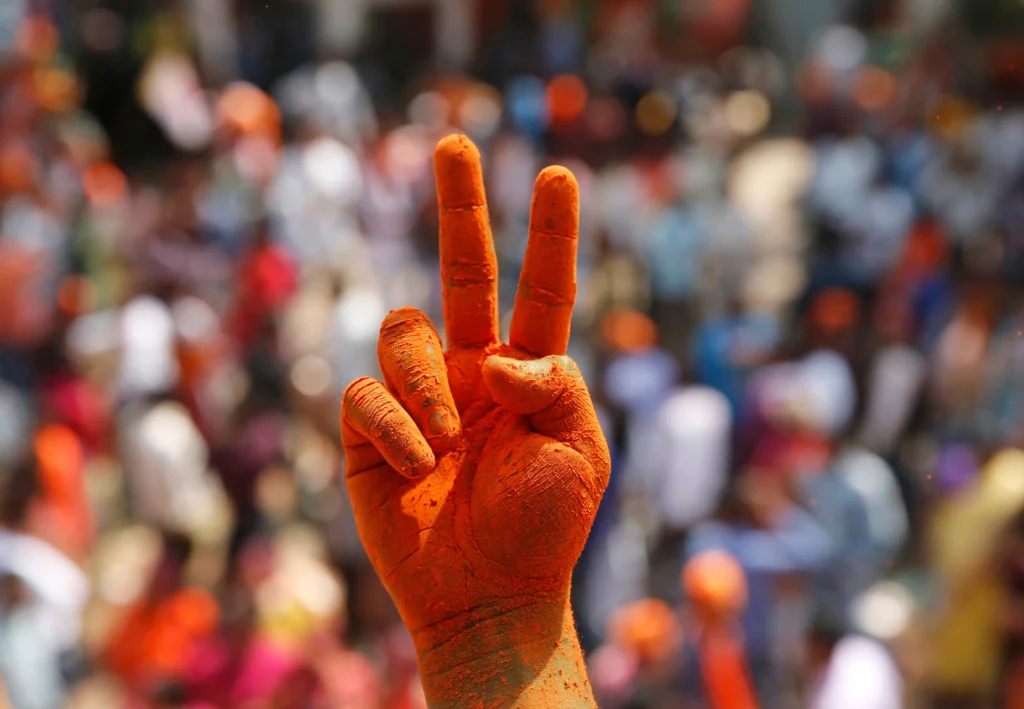
The BJP win in three major states belied the hopes that the run-up to 2024 general elections would mimic that to 2019 national polls when the saffron lost these states to Congress. This time, the BJP not only retained Madhya Pradesh but also took Congress ruled Rajasthan and Chhattisgarh. Except for its government in Himachal Pradesh, the Congress has now been wiped off the map of North India, making Arvind Kejriwal rub it in that the AAP is the largest ruling opposition party in North India with governments in Delhi and Punjab.
That said, the BJP’s scintillating victories have made it even more favourite to win the upcoming national polls, now just four months away. And who knows, the Hindutva party could even surpass the 302 seats it won in 2019. The BJP is now entrenched in most of North India, also called the Hindi heartland. It rules in Uttar Pradesh, Gujarat, Madhya Pradesh, Rajasthan, Chattisgarh, which between them send over 150 seats to parliament.The BJP may not secure all these seats in parliamentary polls, yet winning a significant number of them would put the party close to a majority, even with moderate success in other states.
The Congress party, on the other hand, has once again been humbled. The party’s march towards revival following Rahul Gandhi’s 4000 kilometres Kanyakumari to Kashmir padyatra last year has all but petered out. Its wins in Himachal and Karnataka that came about in the heady aftermath of the yatra seem now a thing of the past. Rahul seems to have again lost the initiative leaving the Congress adrift. In fact Rahul’s predicament is emblematic of a larger dilemma faced by the Congress — a desperate need to reinvent, reinvigorate, and present a compelling ideological alternative. It’s not merely about countering Modi’s charisma but about crafting a vision that transcends familial legacy and resonates deeply with India’s diverse population. The need to do so has become even more urgent now. The results of five state elections have made it clear that the prime minister Modi’s wave remains alive and kicking. Notwithstanding a few reverses here and there, the PM has only grown stronger despite being a decade in power.
At the same time, not all is lost for the opposition. In 2003, the then BJP government led by Atal Bihari Vajpayee decided to advance the Lok Sabha poll by six months after winning Madhya Pradesh, Rajasthan and Chattisgarh but suffered a defeat at the hands of a Congress-led United Progressive Alliance. However, it is also true that the BJP is now a far different party to what it was then. Under Vajpayee, the BJP was more or less indistinguishable from Congress. Vajpayee ran a tame, coalition government subject to preferences of its allies, most of whom were secular in their outlook. The BJP today is a disproportionately bigger political entity which is not only immensely more popular but is also way ahead of others in its handling of the electoral process. So, the history is unlikely to repeat.
Besides, as the elections in India over the past decade have demonstrated, they have hardly been fought over bland issues of governance, or for that matter, even those of the economy. The exercise has largely been out and out about the overarching persona of the PM Modi and Hindutva. The biggest undoing of the Congress and the broader opposition is that they have both failed to produce a pan-India leader to match the charisma of Modi and to build an alternative narrative that rivals Hindutva. The failing has been monumental in the case of Congress, the grand old party that steered India to its freedom. Since 2014, as Hindutva became a reigning ideology of the country, the Congress has displayed a stunning lack of conviction in its foundational creed. It has chosen to play second fiddle to the BJP on ideology and peddle soft Hindutva. Congress doubled down on a mild majoritarian posturing in Madhya Pradesh and Rajasthan in the hope that it could project itself as a more endearing alternative to the BJP’s aggressive Hindutva. But as the outcome has proved, the voters preferred the bonafide purveyor of the ideology.
Also, by attempting to be the BJP-lite, the Congress has undercut the credibility of its own political vision. The party falls short in providing anything unique that the BJP cannot excel at far more effectively: The saffron party adeptly merges a broad welfarist governance approach with its ideological agenda, effortlessly fulfilling even its ambitious India-remaking goals. As against this, the ideological vision of the Congress and the other opposition parties looks vague and insipid.
It is this yawning gulf that the INDIA Alliance needs to bridge – now at a very short notice – if it hopes to credibly challenge the saffron party in the upcoming general elections. Without this concerted effort, the BJP’s third consecutive win seems all but assured.
- Views expressed in the article are the author’s own and do not necessarily represent the editorial stance of Kashmir Observer
Follow this link to join our WhatsApp group: Join Now
Be Part of Quality Journalism |
Quality journalism takes a lot of time, money and hard work to produce and despite all the hardships we still do it. Our reporters and editors are working overtime in Kashmir and beyond to cover what you care about, break big stories, and expose injustices that can change lives. Today more people are reading Kashmir Observer than ever, but only a handful are paying while advertising revenues are falling fast. |
| ACT NOW |
| MONTHLY | Rs 100 | |
| YEARLY | Rs 1000 | |
| LIFETIME | Rs 10000 | |












